Inroduction
The flora of Florida is highly diverse due to a subtropical climate that supports a vast number of plant species that are highly useful and beneficial as food, fiber, or ornamentals, or for the ecosystem services they provide. Unfortunately, the Florida climate is also conducive to supporting the growth and spread of numerous invasive plant species and weeds that can become problematic in home landscapes. Homeowners are typically aware or soon learn of the damage that can result from keeping invasive plants in a landscape and may have experience with weeds becoming a nuisance in their home garden or lawn. However, for homeowners who have small children, pets, or even livestock such as horses or sheep, they should also be aware that certain invasive plants and weeds can be toxic if consumed.
Just because a plant has some toxic properties does not mean that it shouldn’t be used or that it must be removed—many common ornamentals and native plants can be toxic but still provide numerous benefits such as food or cover for wildlife, pollinator habitat and food sources, or aesthetic appeal. The key is to be informed and know which species are toxic to prevent accidental exposure, especially when small children or pets could be inadvertently exposed. This EDIS publication is intended to inform home gardeners, pest management professionals, and other plant enthusiasts of some of the most common poisonous invasive plants or weed species common in home landscapes in Florida, with particular focus on species that could potentially cause harm if ingested.
Common Pokeweed (Phytolacca americana)
Other Common Names
American pokeweed, garnet, pokeberry, pigeon berry, inkberry
Family
Phytolaccaceae (Pokeweed family)
Life Span
Perennial
Distribution and Habitat
Common pokeweed is native to North America. It is commonly found from Maine to Florida and as far west as Texas to New Mexico and Arizona (USDA-NRCS 2019). It is commonly found in wooded areas, pastures, fence rows, crop fields, areas under power lines, old fields, and other similar areas. In landscapes it is often seen in planting beds or bordering wooded areas. It can be considered a garden or yard weed but can be an important wildlife food source. The widespread distribution of common pokeweed is due to wild birds that are known to consume pokeberries, the fruit of the common pokeweed. Additionally, it seeds itself easily and grows well in average to medium moisture in well-drained soil under full or part shade.
Biology
Pokeweed is a herbaceous perennial plant that can grow 4 to 10 feet high (Figure 2). In optimal conditions, the plant can grow up to 21 feet tall, but it is usually found growing much smaller. Pokeweed flowers in the warm weather in Florida starting from July to September (Stephens 2018). The fruits are green when immature and turn into purple berries once matured (Figure 1). The berries mature in late summer to fall and attract a range of birds.
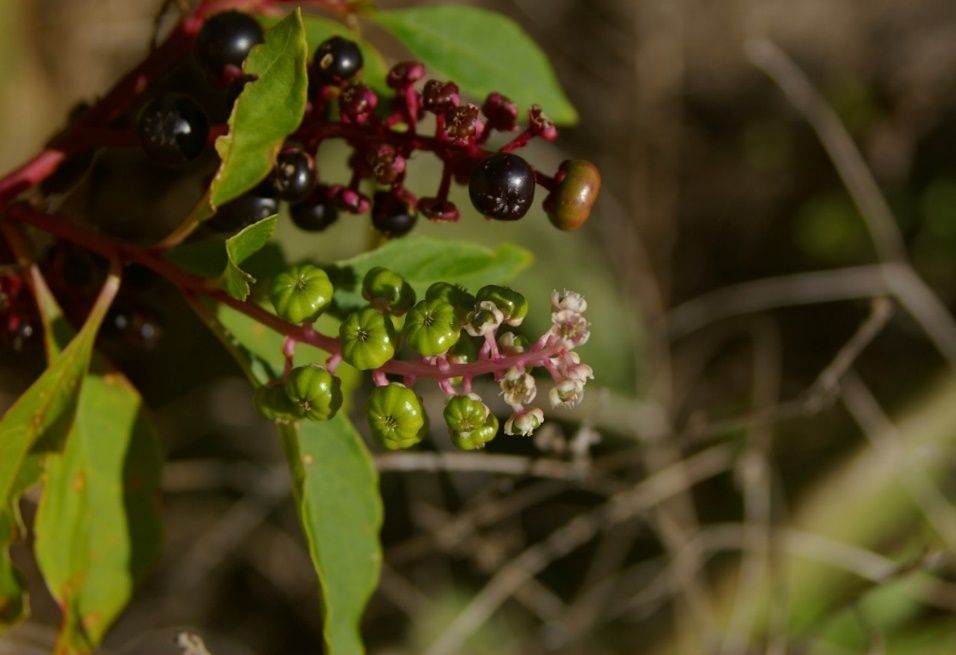
Credit: Annette Chandler, UF/IFAS
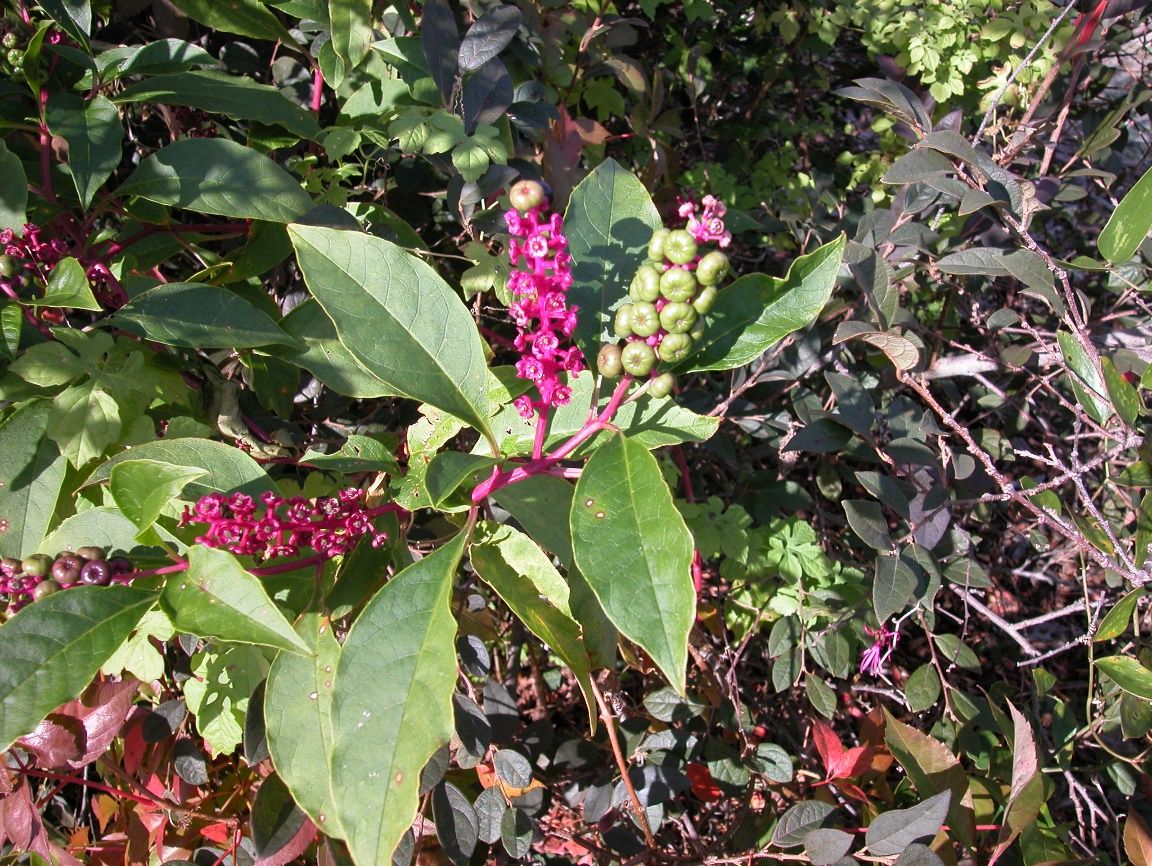
Credit: Annette Chandler, UF/IFAS
Toxicity
The entire plant is poisonous, and depending on the quantity of plant consumed, it can even cause death in rare cases. It is largely toxic to cattle, sheep, poultry, horses, dogs, and humans (Barnett 1975). All parts of the plant contain alkaloids, such as saponins, oxalates, and phytolacine, which are toxic. Pokeweed can produce over 48,000 seeds per plant, with the highest concentration of toxin present in the seeds and roots of the plant.
More information on pokeweed biology, identification, and control can be found in the EDIS publication Common Pokeweed.
Wild Garlic (Allium canadense)
Other Common Names
Meadow garlic, wild onion, Canadian garlic, and Canada onion
Family
Amaryllidaceae
Life Span
Perennial
Distribution and Habitat
Wild garlic is native to North America and commonly found in the entire eastern half of the United States, ranging from Florida to Canada (USDA-NRCS 2022). Allium canadense L. var. canadense and Allium canadense var. mobilense are two varieties of Allium canadense native to Florida (Wunderlin 2022). It is normally found growing in disturbed areas, open fields, ditches, roadways, home lawns, and gardens. The plant commonly spreads through bulb offsets and aerial bulbs.
Biology
Wild garlic is a grasslike perennial plant that can grow about 18 inches tall (Figure 4). Wild garlic has a strong onion-like odor when leaves are crushed or mowed. The flowers are a cluster of star-shaped pink or white colors and blooms from spring to summer (Figure 3).
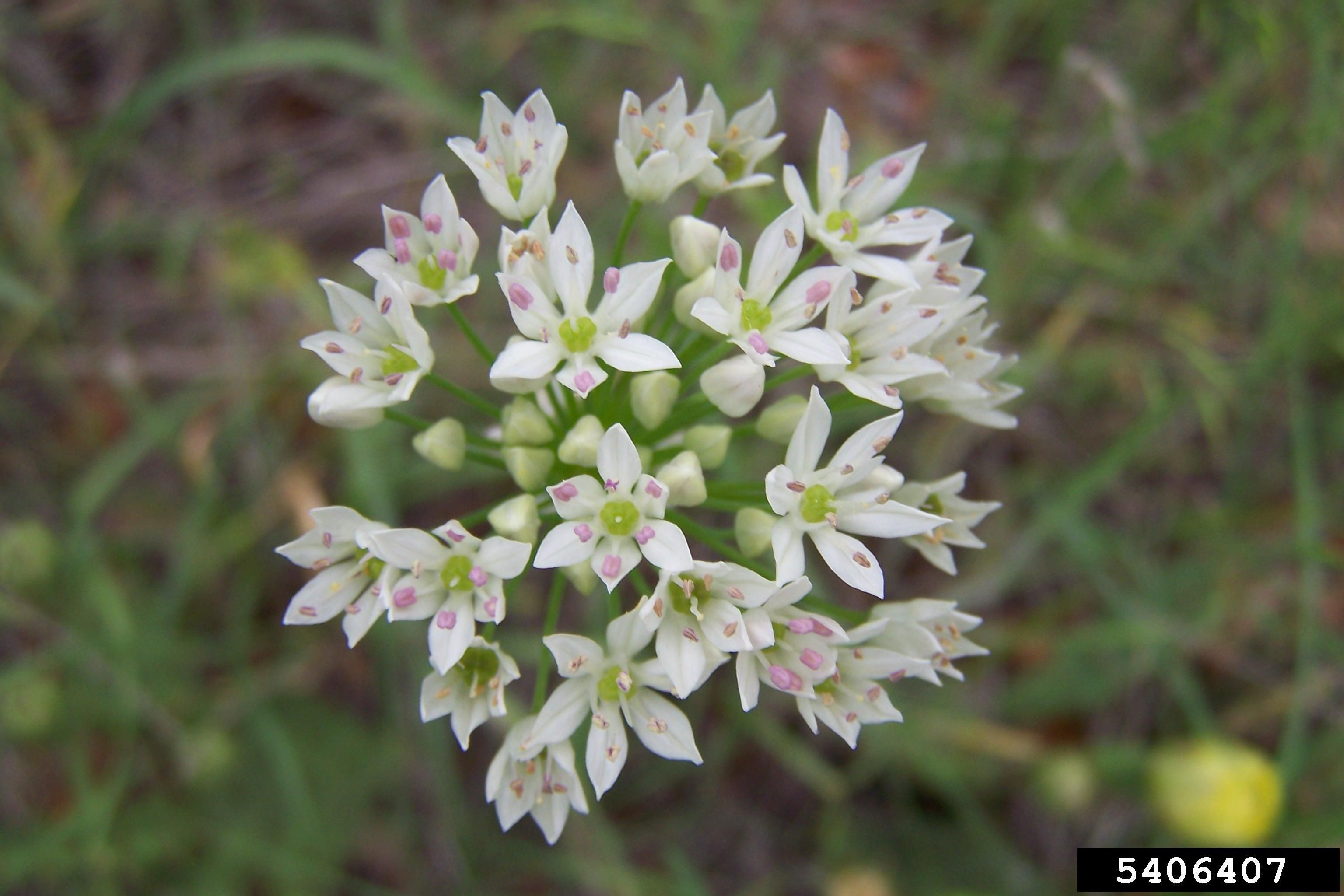
Credit: Karan A. Rawlins, University of Georgia, Bugwood.org
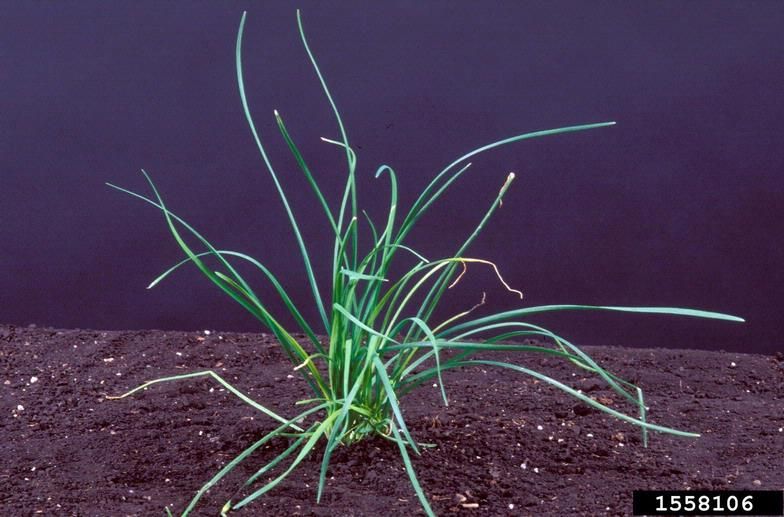
Credit: Ohio State Weed Lab, The Ohio State University, Bugwood.org
Toxicity
Dogs, cats, and cattle are highly susceptible to Allium toxicity. The common symptoms include vomiting, diarrhea, abdominal pain, muscle weakness, and rapid heart rate. Eating a large amount of this plant has resulted in death in a few cases, but it is rare for animals to eat the plant excessively if other food sources are present. The toxic chemical called N-propyl disulfide results in hemolysis (rupture of red blood cells) in livestock (Cope 2005). Other closely related Allium spp., such as onion grass (Allium vineale), onion (Allium cepa), garlic (Allium sativum), leek (Allium porrum), and chives (Allium schoenoprasum), have a similar effect on dogs, cats, and cattle.
Bitter Sneezeweed (Helenium amarum)
Other Common Names
Yellow sneezeweed, bitterweed, yellow bitterweed, slender-leaved sneezeweed, yellow dogfennel
Family
Asteraceae (Aster family)
Life Span
Annual
Distribution and Habitat
Bitter sneezeweed is an herbaceous annual plant native to North America. It is primarily found growing in sandy soil ranging from Florida, Virginia, Missouri, Kansas, and Texas. It is commonly found in disturbed areas, pastures, sandy ground, railroad tracks, backyards, and in some cases home gardens. It can be used as a plant in pollinator gardens because it attracts bees and butterflies, which frequently visit the plant while in flower. It grows best in subtropical temperatures and dry soil, but it can adapt to different soil conditions.
Biology
Bitter sneezeweed is a summer annual that grows up to 24 inches tall (Figure 5). The flowers bloom from August to October with few blooms occurring in warm, mild winter climates (Figure 6). It reproduces through seeds and is primarily dispersed by wind and animals. It is a fast-growing species and produces mature seeds in as little as eight weeks following germination.
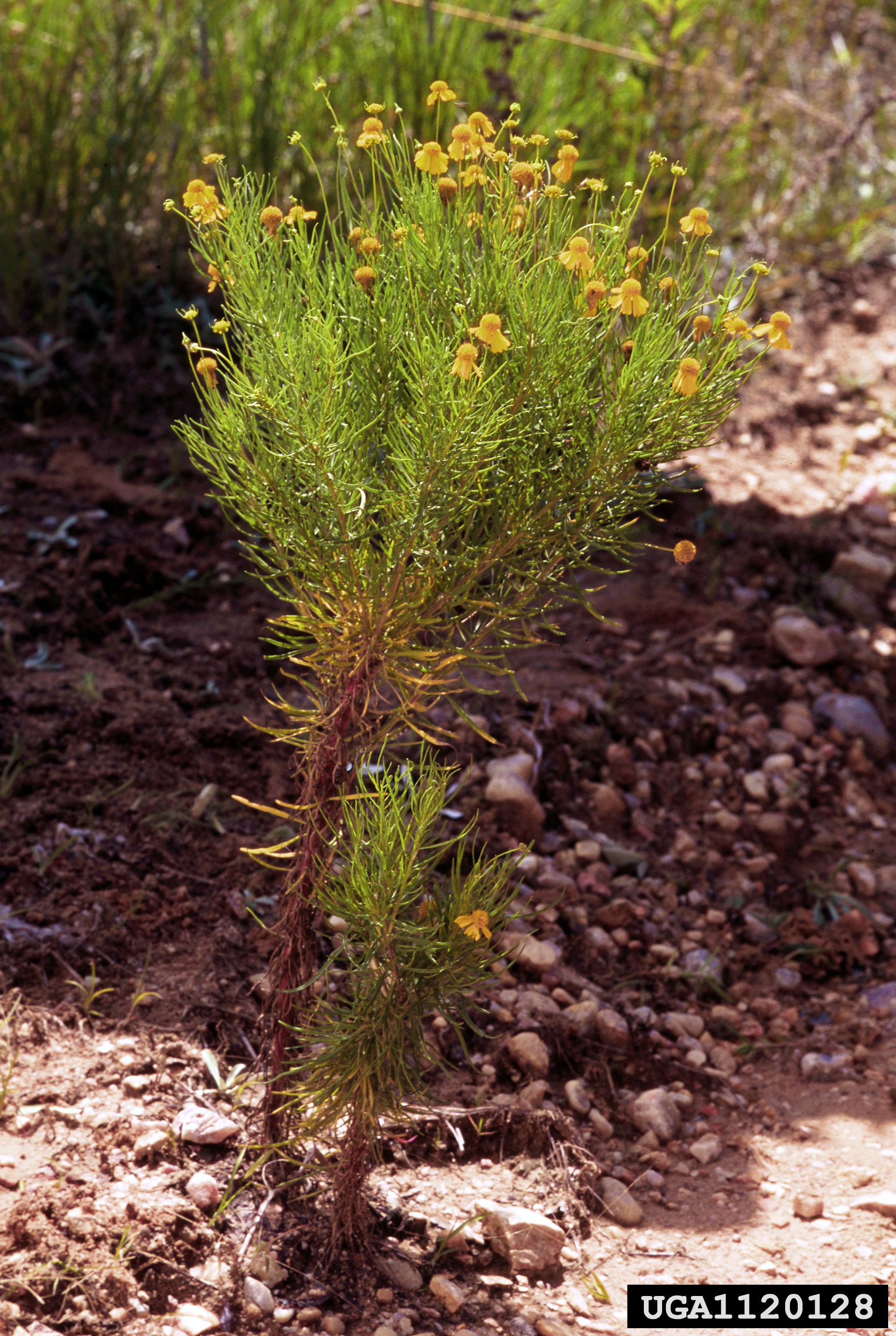
Credit: James H. Miller & Ted Bodner, Southern Weed Science Society, Bugwood.org
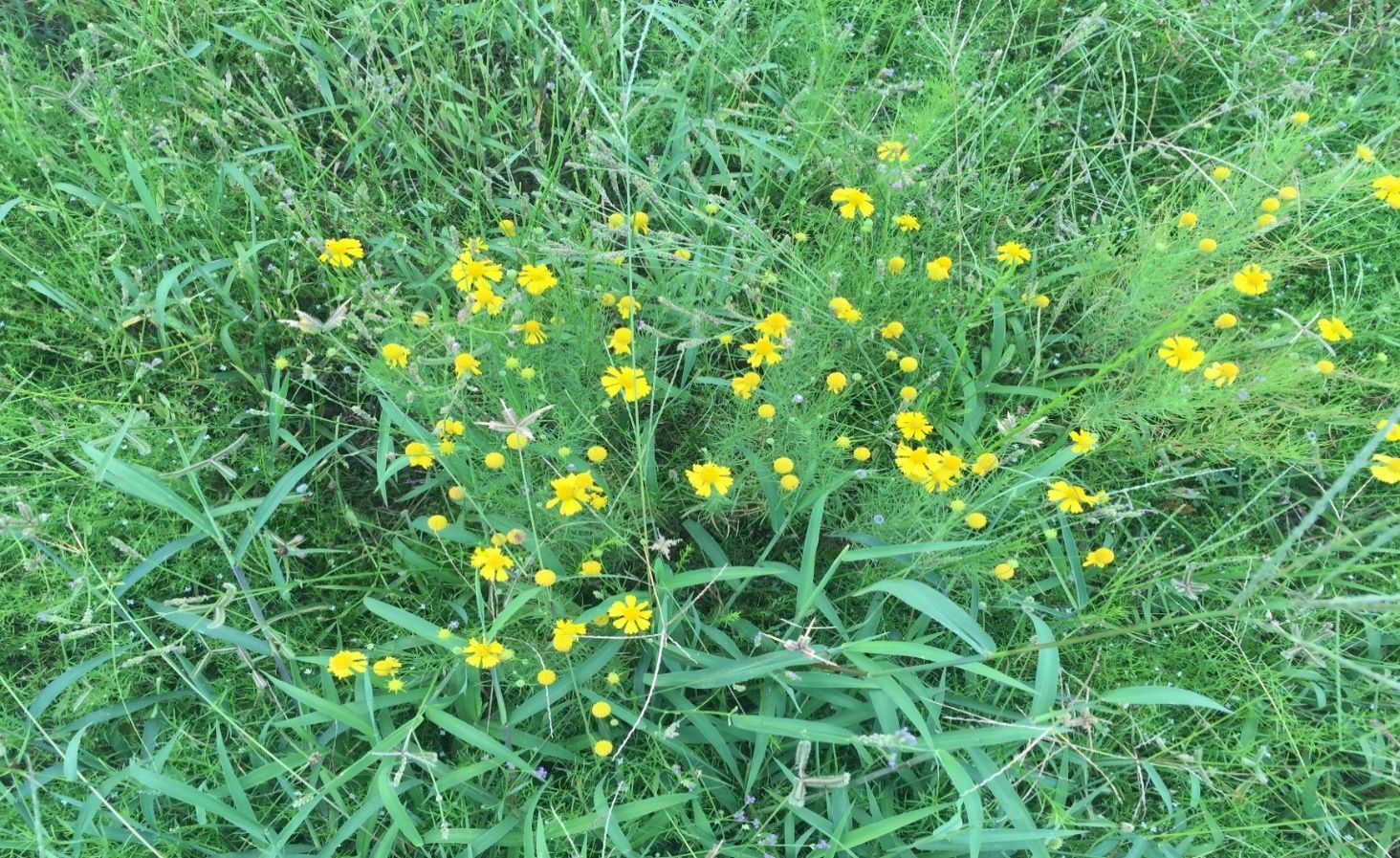
Credit: John D. Byrd, Mississippi State University, Bugwood.org
Toxicity
Bitter sneezeweed is primarily a concern for grazing animals because it is poisonous to sheep, cattle, horses, and goats (Kingsbury 1964). However, it has also been reported as being toxic to humans and some pets (Trull n.d.). The toxic chemicals present in bitter sneezeweed is a glucoside, dugaldin, and phenol. The plant retains its toxicity even after drying and can be a problem in contaminated hay. In many cases, it causes vomiting, which can develop into inhalation pneumonia. Other symptoms consist of digestive disturbances, neurological problems, dullness, trembling, and weakness. The common name bitterweed is because it causes milk to taste bitter when cows graze on the foliage.
Air Potato (Dioscorea bulbifera)
Other Common Names
Air potato, air potato vine, air yam, bitter yam, aerial yam, air yam
Family
Dioscoreaceae
Life Span
Perennial vine
Distribution and Habitat
Air potato is native to tropical Asia and sub-Saharan Africa. It was recognized as a category 1 invasive plant by the Florida Invasive Species Councilin 1993 and also added to the Florida Noxious Weed List by the Florida Department of Agriculture and Consumer Services in 1999 (Enloe and Langeland 2021). It can be found growing in moist forests, disturbed areas, urban forests, forest edges, ruderal areas, and along roadsides. In tropical hammocks, it is seen heavily concentrated in canopy gaps. It is a common invasive plant in residential landscapes because it often grows on the edges of wooded areas or up trees growing in the landscape.
Biology
Air potato is an aggressive herbaceous perennial vine that can grow up to 60 feet in length (Figure 7). It is highly invasive because it can reproduce sexually via seeds and vegetatively by underground or aerial tubers (Figure 8). Flowers are small, fragrant, and white or pinkish colored, but the plant rarely flowers in Florida. It prefers to grow in areas with high temperatures, high humidity, and high rainfall. The plant grows best in loamy soil with good drainage, but it does not tolerate salty or frost conditions well.
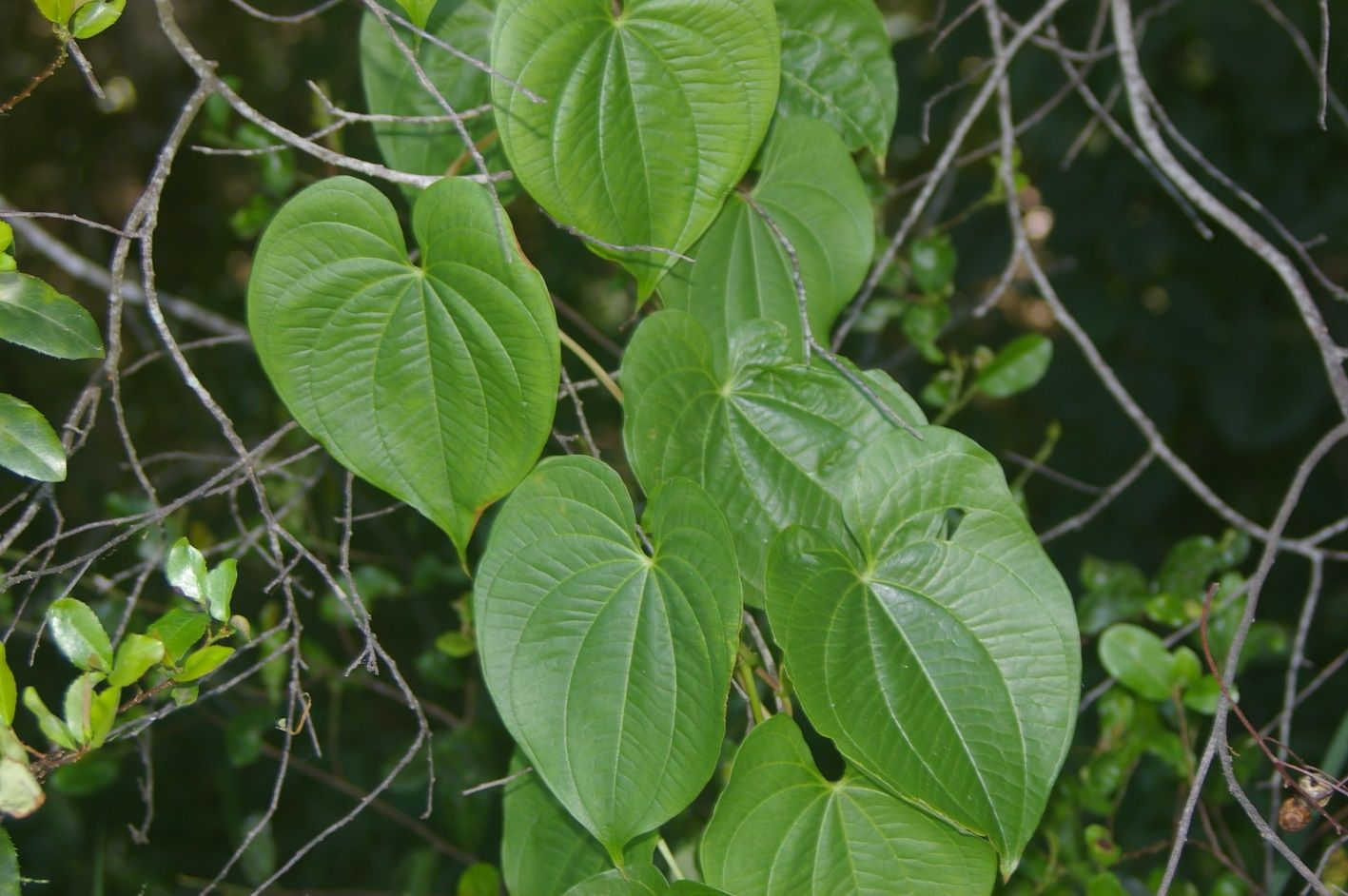
Credit: Annette Chandler, UF/IFAS
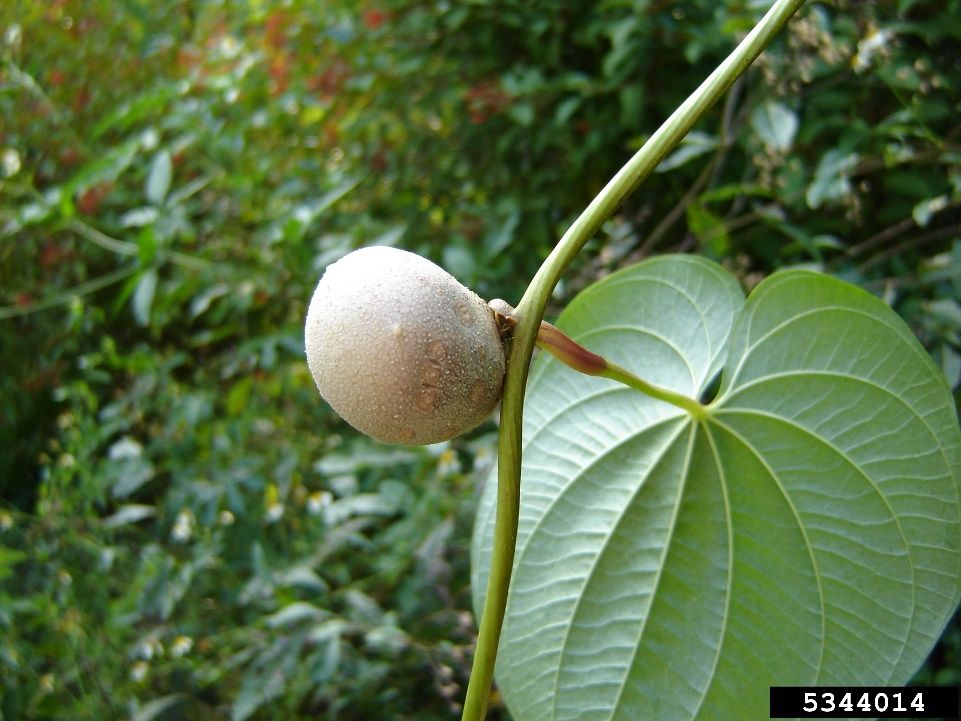
Credit: Karen Brown, University of Florida, Bugwood.org
Toxicity
Air potato is poisonous to humans. It has been shown to cause severe liver injury or impairment of liver function also known as hepatotoxicity (Guan et al. 2017). The main toxic component present in both underground tubers and aerial bulbils is a steroid diosgenin that can damage the liver. A detailed guide to the identification and management of this species is available in the article Invasive Plants in Natural Areas: Air Potato (Dioscorea bulbifera).
Balsam Pear (Momordica charantia)
Other Common Names
Bittermelon, bitter gourd
Family
Cucurbitaceae
Life Span
Annual
Distribution and Habitat
Balsam pear is native to subtropical regions of Africa and Asia (Englberger 2009) but is now widely distributed throughout tropical and subtropical regions throughout the world. In Florida, balsam pear is mostly found in central and south Florida. It is a common weed in agricultural fields and in landscapes, mostly growing in landscape planting beds where it grows up and/or over ornamentals and small trees (Holm et al. 1997).
Biology
Balsam pear is a fast-growing summer annual vine (Figure 9) with a central taproot that can grow over 20 feet in length and is highly branched. In Florida, it typically begins germinating in late spring through summer in central Florida but can germinate almost year-round in south Florida. Flowering can begin as early as 30 days after seed germination. Fruits are egg-shaped and covered with ridges and warts. They are first green but then turn orange at maturity and split open, revealing bright red arils (seed covering) that cover the seeds (Figure 10).
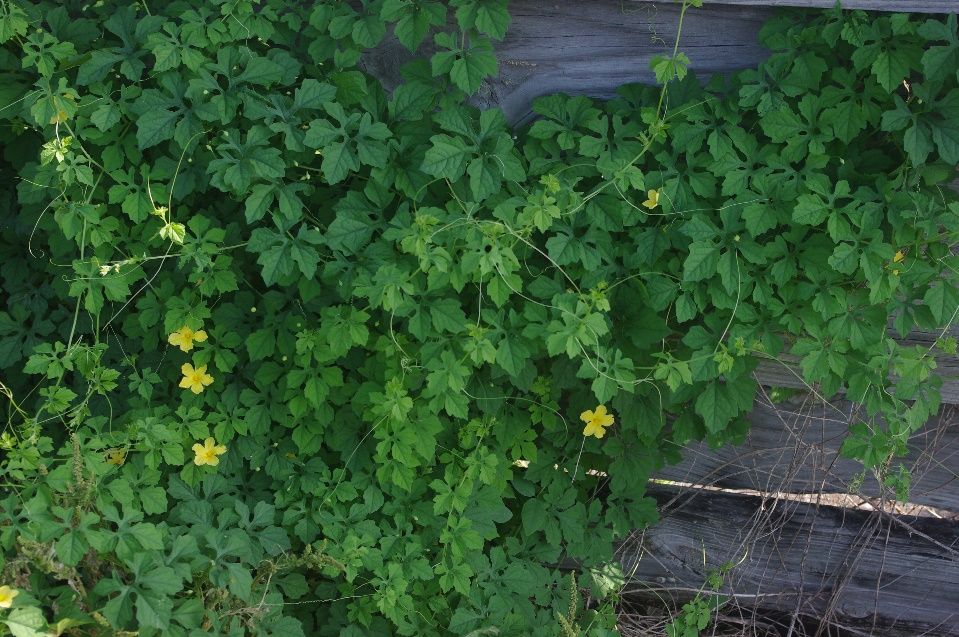
Credit: Annette Chandler, UF/IFAS
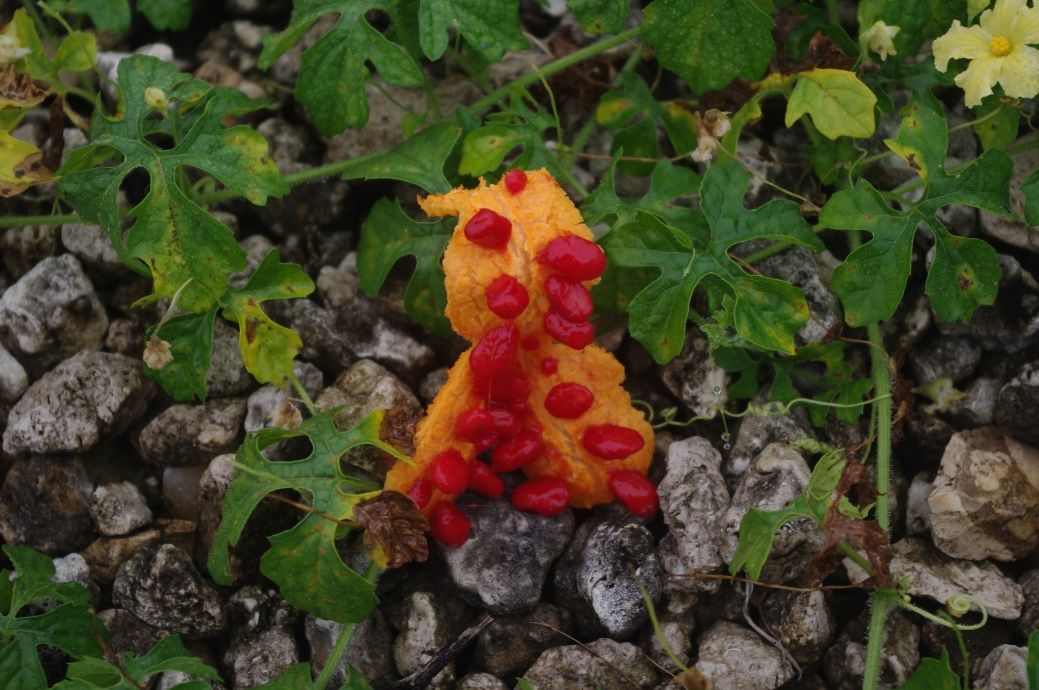
Credit: Annette Chandler, UF/IFAS
Toxicity
Balsam pear is widely cultivated in tropical and subtropical regions around the world as a food crop and due to its many medicinal uses and reported health benefits (Basch et al. 2003). The red arils surrounding the seed and green fruit are reportedly edible, as well as other parts of the plant if cooked, but the seeds (if swallowed) and ripe orange fruit can potentially make people and pets very ill if swallowed (Walters and Decker-Walters 1988).
Chinese Wisteria (Wisteria sinensis)
Other Common Names
Chinese wisteria
Family
Fabaceae (Legume family)
Life Span
Perennial vine
Distribution and Habitat
Chinese wisteria, as the name suggests, is native to China. In North America, it is naturalized from Maine to Florida and as far west as Arkansas. It is listed as a category 2 invasive plant by the Florida Invasive Species Council (Wunderlin 2022). Chinese wisteria grows along roadsides, forest edges, old house sites, and abandoned gardens. It is a problem in natural areas because it can climb into the canopy of trees or plants, eventually shading and damaging native plants.
Biology
Chinese wisteria is an aggressive perennial woody vine. It can grow as tall as the height of the plant it is climbing and can be more than 65 feet in length. It reproduces by rooting at each node, through stolons (underground runners), and vegetatively from cut stem pieces. Chinese wisteria blooms from March to early April. The flowers are showy, dangling, fragrant, and blue to violet in color (Figure 11).
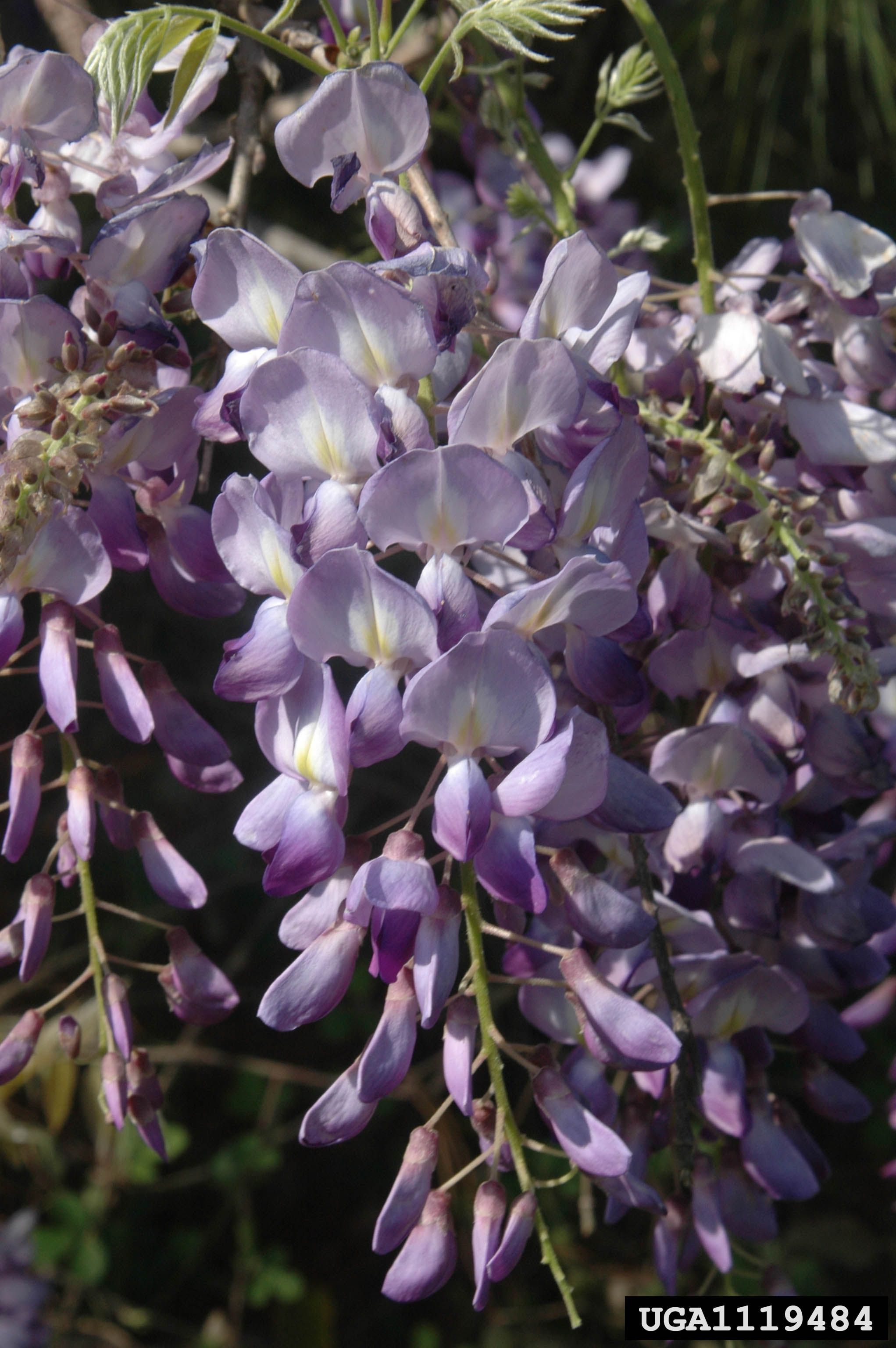
Credit: Chris Evans, University of Illinois, Bugwood.org
Toxicity
Chinese wisteria is toxic to both humans and pets (Kayalvizhi et al. 2020). Every part of the plant contains a glycoside toxic compound called wisterin. The symptoms range from stomach pain, burning sensation in the mouth, vomiting, and diarrhea. The pods and seeds have the highest concentration of wisterin.
Creeping Indigo (Indigofera spicata)
Other Common Names
Trailing indigo
Family
Fabaceae (Legume family)
Life Span
Perennial herb
Distribution and Habitat
Creeping indigo is native to Africa and southeastern Asia. Creeping indigo was introduced in Florida around 1925 as a potential forage crop for the livestock industry. It is generally found in disturbed grasslands, open fields, pastures, cultivated areas, gardens, and lawns. It thrives in clay soil but can tolerate and adapt to a range of soil types, including limestone, sandy, low-nutrient, and phosphorus-deficient soils.
Biology
Creeping indigo is a perennial prostrate creeping herb (Figure 12). The stems can grow up to 6 feet long and form roots at each node. The plant can reproduce by seed and stem cuttings (Figure 13). The plant flowers during the warm months produce pink flowers on spikes from the bases of the leaves.
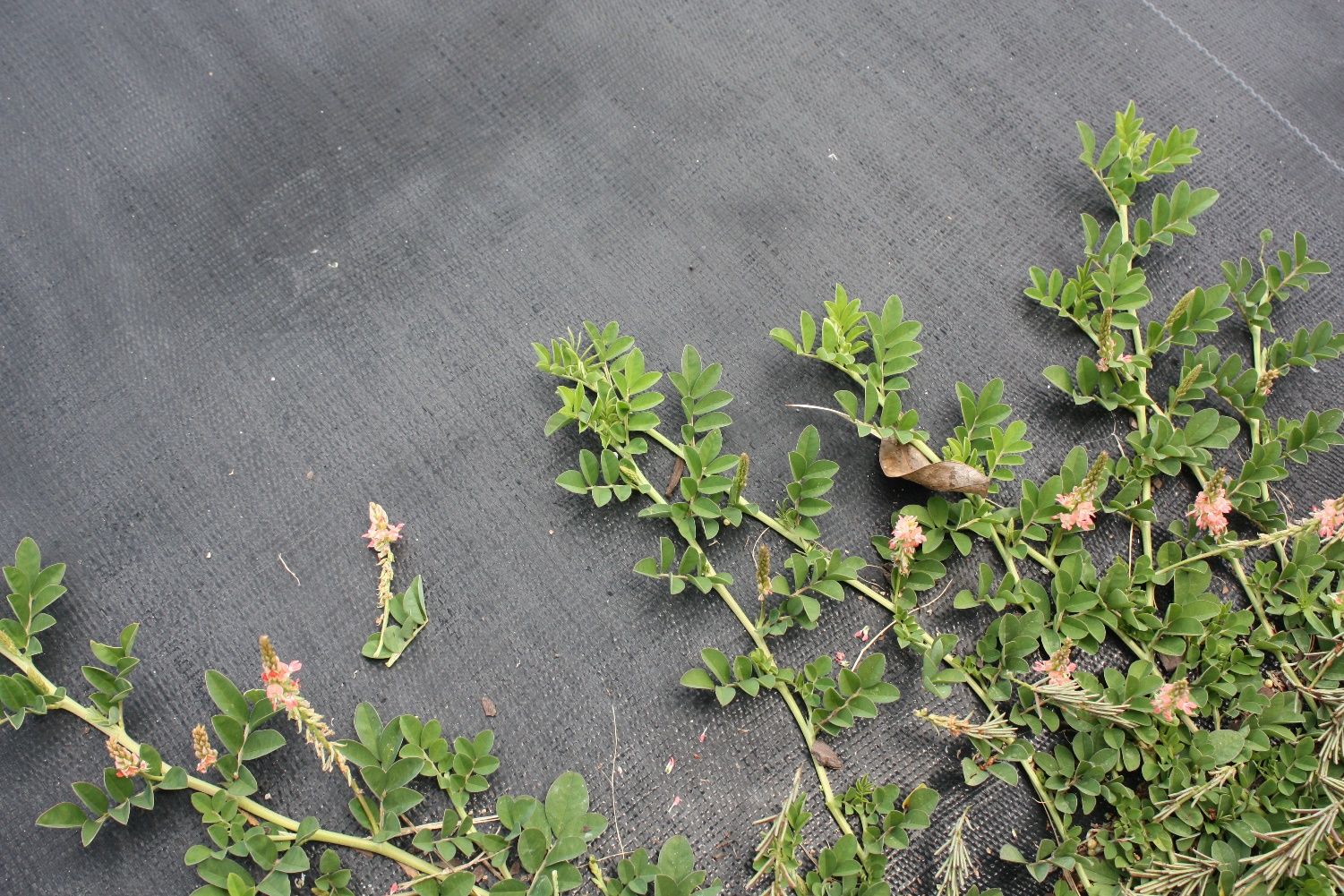
Credit: Annette Chandler, UF/IFAS
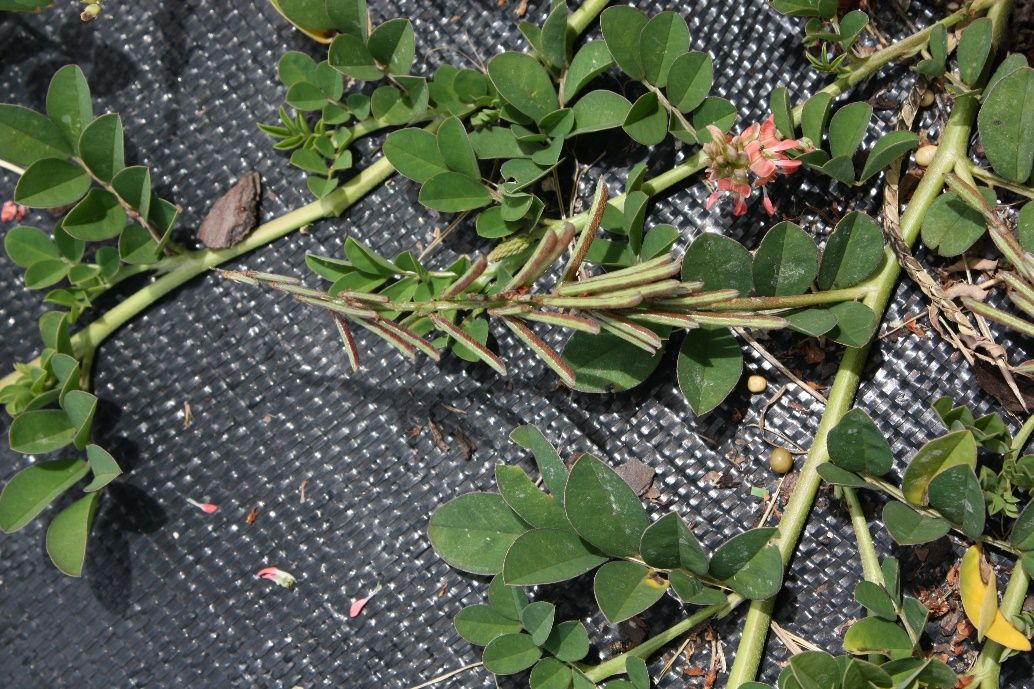
Credit: Annette Chandler, UF/IFAS
Toxicity
Creeping indigo is toxic to livestock and is of particular concern for horses. The leaves and seeds of the plant contain a toxic amino acid called indospicine, which is toxic to the liver. High intake of the plant has been associated with a fatal central nervous system disturbance in horses. Symptoms include weight loss, high heart and respiratory rates, labored breathing, high temperature, and hypersalivation, or foaming from the mouth. Dogs do not typically eat the plant but are reportedly highly susceptible to indospicine toxicity, with secondary poisonings being reported in dogs eating indospicine-contaminated meat (Gardner and Riet-Correa 2011).
A detailed guide to the identification and management of this species is available in the article Creeping Indigo, a Poisonous Plant of Concern in Florida Pastures.
Chinaberry (Melia azedarach)
Other Common Names
Cape lilac
Family
Meliaceae
Life Span
Perennial tree or small shrub
Distribution and Habitat
Chinaberry is native to southeastern Asia but has been cultivated throughout the world as an ornamental (Waggy 2009). It is highly invasive in Florida, categorized as a category 2 invasive by the Florida Invasive Species Council and has naturalized in many subtropical regions in the world. It can be found growing throughout all parts of Florida and is primarily a concern in natural areas, where it can form dense thickets and outcompete native vegetation. Because it was once used an ornamental plant, it is often seen growing in wooded areas of residential neighborhoods or may be found growing as a shade tree in some landscapes. It is highly tolerant of a wide range of soil conditions, and its seeds are dispersed by wildlife, primarily birds.
Biology
Chinaberry is a fast-growing deciduous to semievergreen tree or shrublike plant (Figure 14) (particularly after being cut or damaged) that can grow up to 50 feet in height, although it is often observed growing much smaller in residential landscape situations. It flowers from early spring through early summer, and fruits ripen during the fall and winter months (Figure 15) (Waggy 2009).
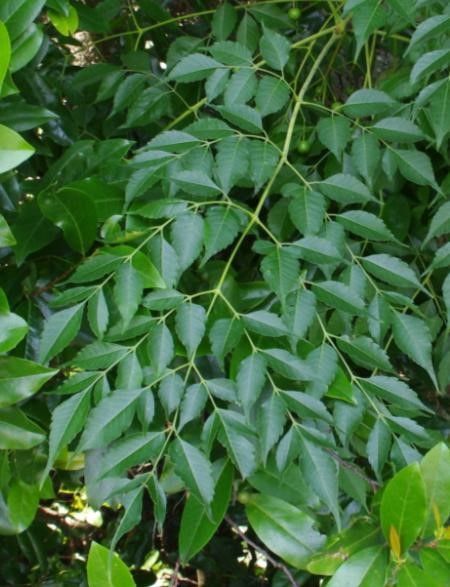
Credit: Annette Chandler, UF/IFAS
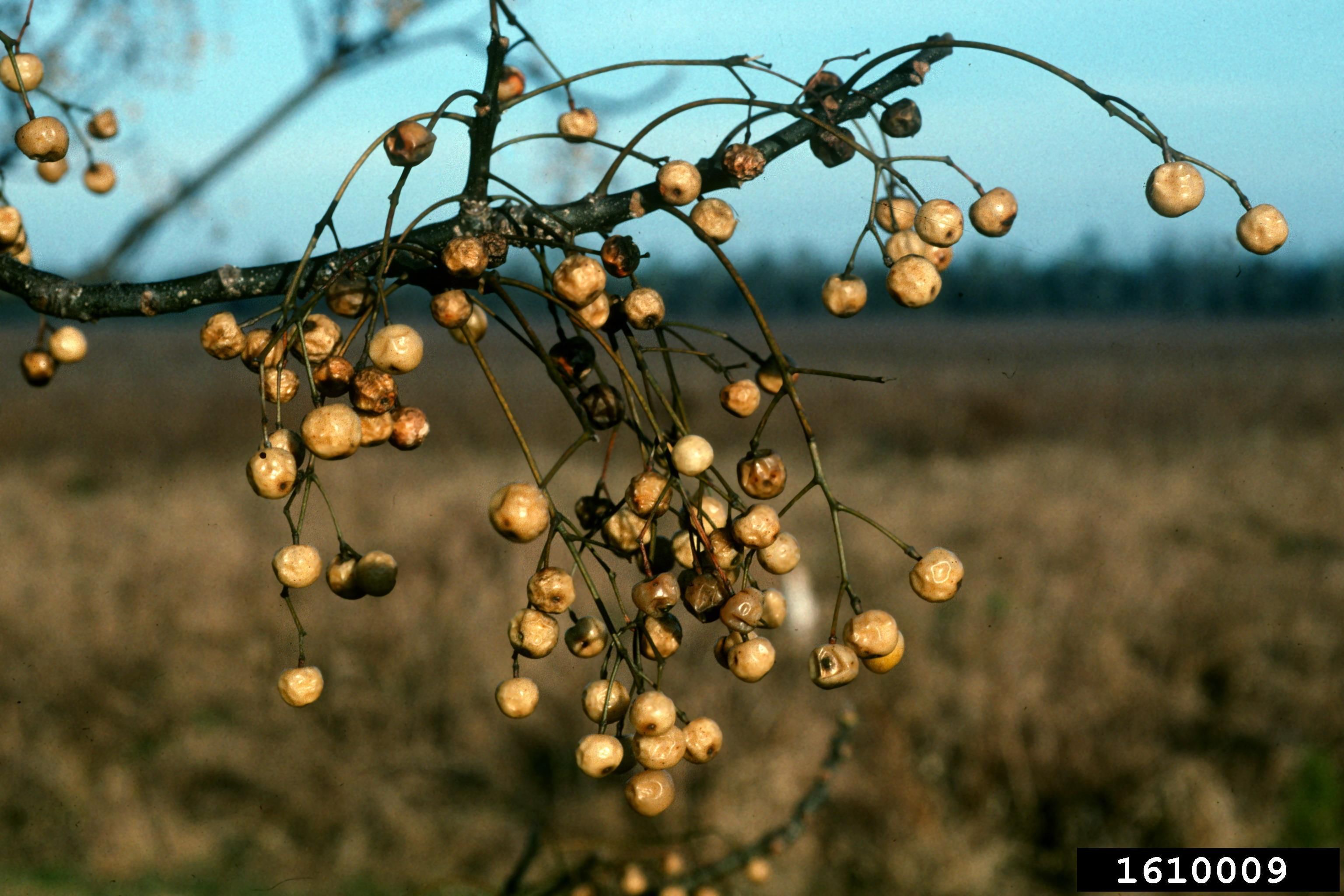
Credit: John Rutger, University of Georgia, Bugwood.org
Toxicity
Flowers can cause respiratory irritation, and the leaves, bark, flowers, and fruit are poisonous, with poisonings from fruit ingestion being reported in people, sheep, cattle, and dogs. Most poisonings occur when fruit are eaten. Symptoms reported include burning of the mouth and throat, vomiting, and stomach pain (Phua et al. 2010).
Virginia Creeper (Parthenocissus quinquefolia)
Other Common Names
Woodbine, thicket creeper, five-leaved ivy
Family
Vitaceae (Grape family)
Life Span
Perennial vine
Distribution and Habitat
Virginia creeper is native to North America and widely distributed throughout the eastern United States with a range as far west as Nebraska, south to Florida, and north to parts of Canada (USDA-NRCS 2022). It has been vouchered in almost all counties in Florida (Wunderlin et al. 2022). It grows in a wide variety of soil types but grows best in moist soils. It is shade tolerant but can grow in full sun and is often found growing along forest edges. In landscapes, it is commonly found in planting beds or growing under the canopy of shade trees, along fences, and in other disturbed sites.
Biology
Virginia creeper is a deciduous to semievergreen vine (Figure 16) that spreads primarily via seed but can root along nodes if growing along the ground. It is a climbing vine that uses tendrils to grow up to 60 feet in height. Seeds begin to germinate in spring, flowering occurs in summer, typically in June to July, and fruit ripen throughout the fall (Figure 17). It can be an important wildlife food because birds and other animals eat the fruit and can use the foliage and thick growth habit as cover (Colandoanto 1991).
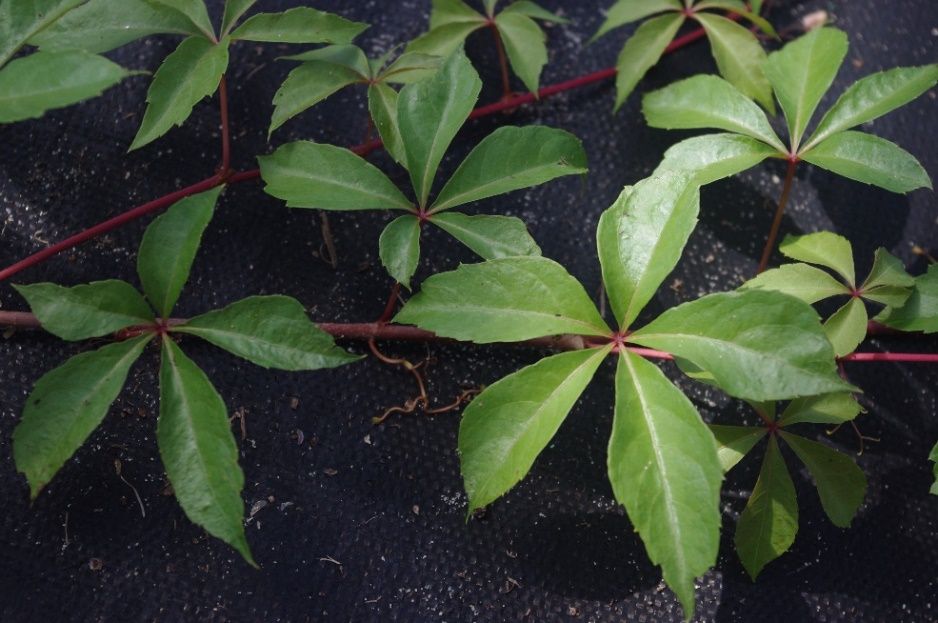
Credit: Annette Chandler, UF/IFAS
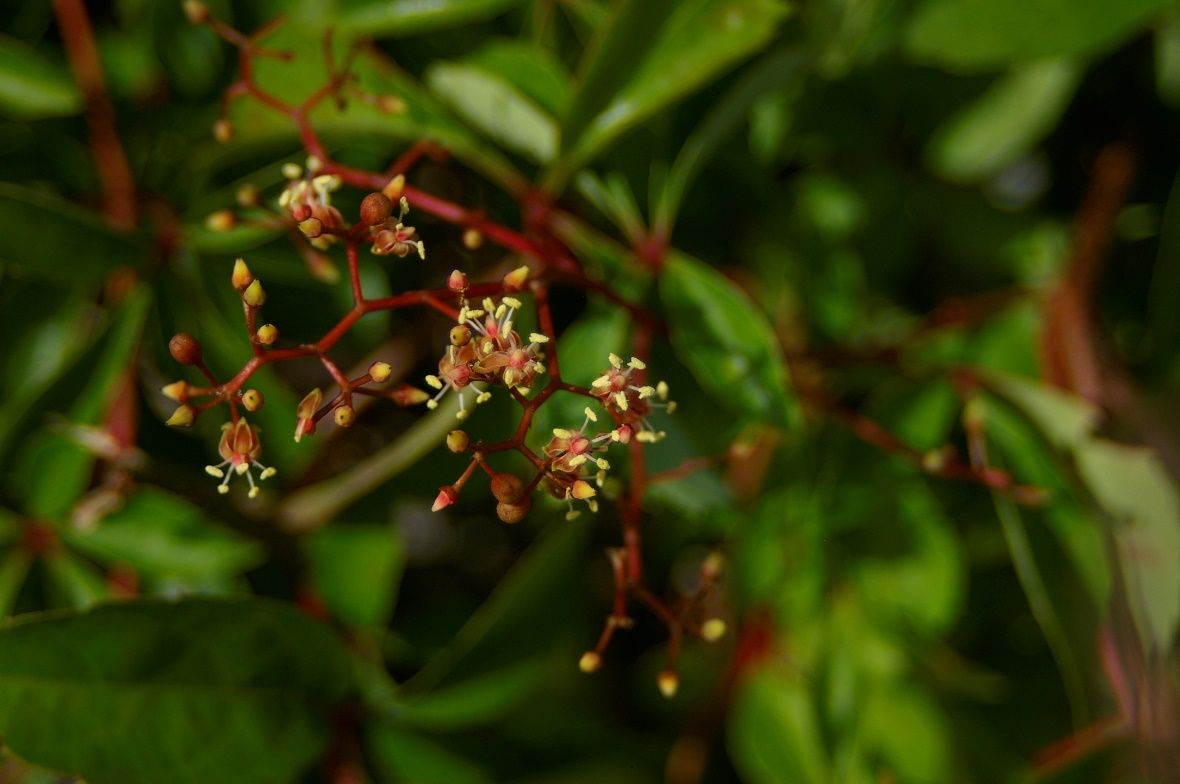
Credit: Annette Chandler, UF/IFAS
Toxicity
While Virginia creeper is a native plant and serves as a wildlife food source, it is highly toxic to children and pets due to the presence of oxalates and other possible compounds that can cause gastrointestinal problems in children eating the leaves or the attractive berries. Symptoms of toxicity are typically excessive salivation and vomiting. Poisonings to various pets have also been reported (CSU 2021).
American Black Nightshade (Solanum americanum)
Other Common Names
American nightshade, black nightshade, common nightshade, garden nightshade, glossy nightshade, ink-berry nightshade, purple nightshade, small-flowered nightshade.
Family
Solanaceae (Nightshade family)
Life Span
Annual or short-lived perennial
Distribution and Habitat
American black nightshade is native to North and South America. The species is widely distributed in Florida. They are commonly found in the forest, grasslands, cultivated gardens, crop fields, and wastelands. The plants thrive in full sun and moist soil but can tolerate partial shade. It is a common weed in vegetable fields and gardens.
Biology
American black nightshade is an erect herbaceous plant that is an annual or short-lived perennial (Figure 18). The plant can grow to a height of 48 inches under optimum conditions. It is one of the most problematic species in the nightshade family. The flowers bloom from March through October. The flowers are star-shaped, usually white, and grow in clusters. The mature fruit of the plant is dull, black, or purplish-black color berries that are about 5 to 8 mm in diameter (Figure 19). It is easily propagated by the dispersal of seeds.
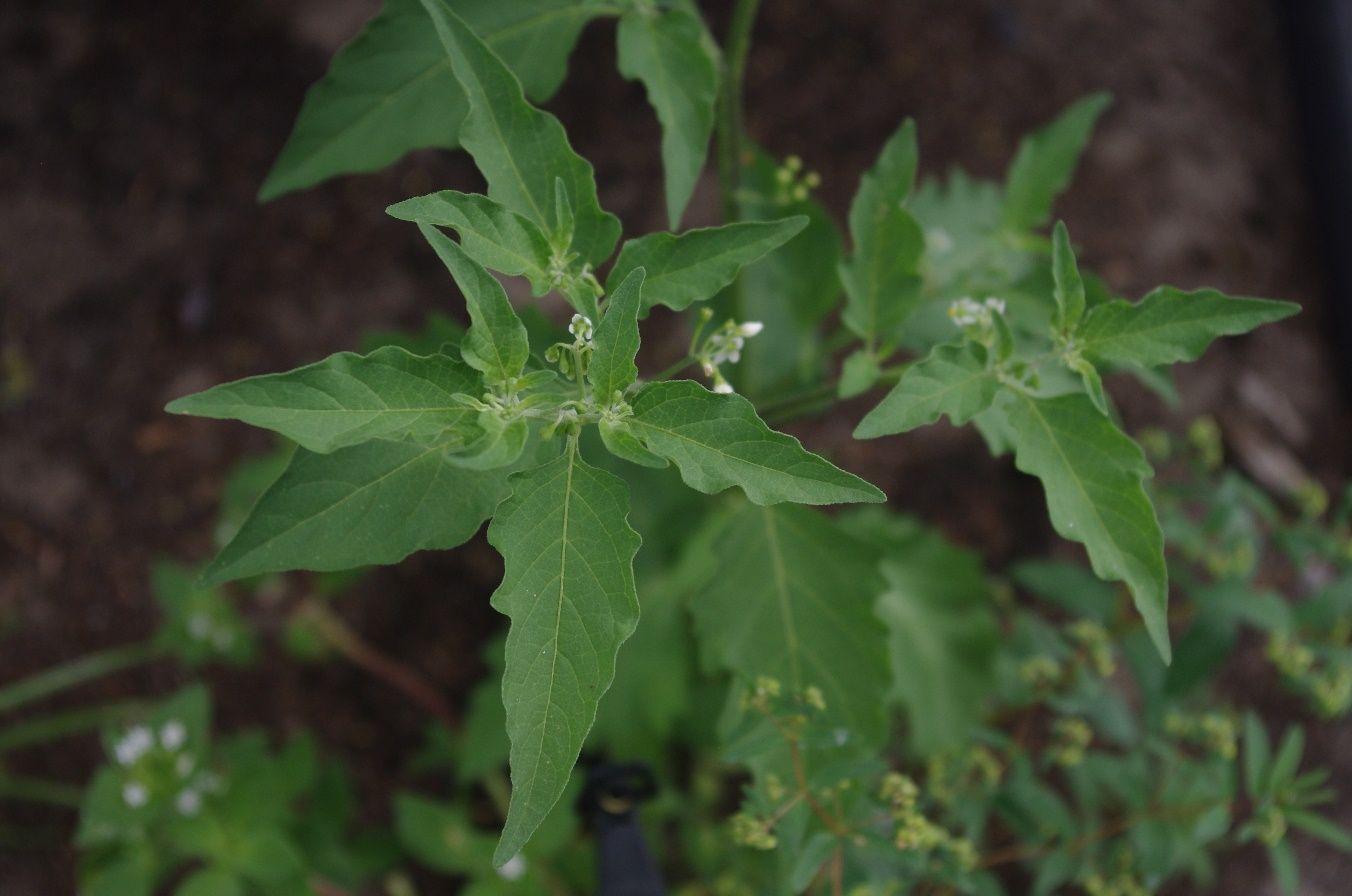
Credit: Annette Chandler, UF/IFAS
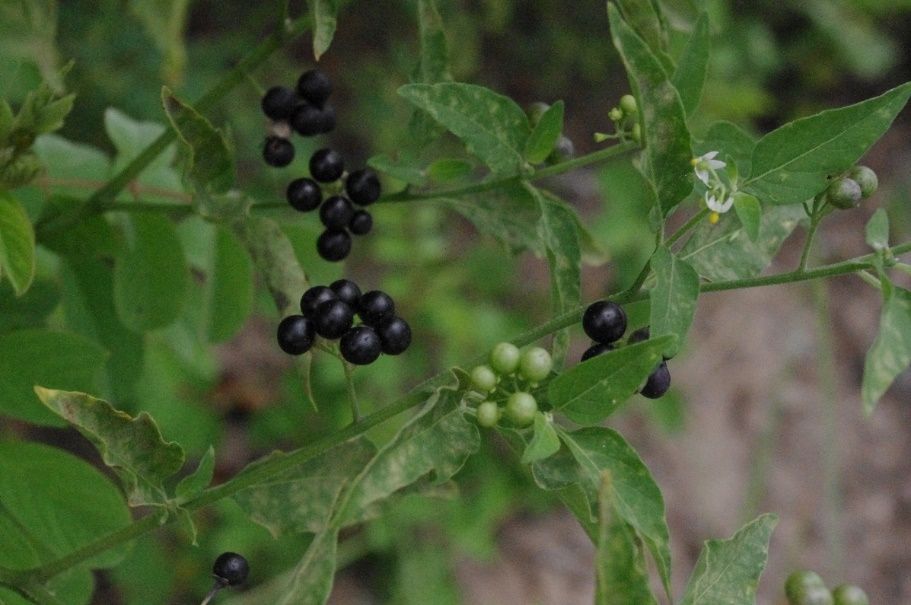
Credit: Annete Chandler, UF/IFAS
Toxicity
All parts of the plants are toxic to humans and pets. The plant contains a toxic compound called solanine. The leaves and berries are the most toxic part of the plant (Milner et al. 2011). The symptoms include gastrointestinal problems, weakness, hallucinations, and it may even cause death if enough is eaten. Other similar species such as Solanum nigrum and Solanum carolinense are also toxic to humans and livestock.
A detailed guide to the identification and management of this species is available in the article Biology and Management of American Black Nightshade (Solanum americanum P. Mill.) in Tomato, Pepper, Cucurbit, and Strawberry.
References
Barnett, B. D. 1975. “Toxicity of Pokeberries (Fruit of Phytolacca americana Large) for Turkey Poults.” Poultry Science 54 (4): 1215–1217. https://doi.org/10.3382/ps.0541215
Basch, E., S. Gabardi, and C. Ulbricht. 2003. “Bitter Melon (Momordica charantia): A Review of Efficacy and Safety.” Am. J. Health Syst. Pharm. 60 (4): 356–359. https://doi.org/10.1093/ajhp/60.4.356
Coladoanto, M. 1991. Parthenocissus quinquefolia. US Department of Agriculture, Forest Service, Rocky Mountain Research Station, Fire Sciences Laboratory. https://www.fs.usda.gov/database/feis/plants/vine/parqui/all.html
Cope, R. B. 2005. “Allium Species Poisoning in Dogs and Cats.” Veterinary Medicine 100 (8): 562.
Colorado State University (CSU). 2021. “Guide to Poisonous Plants.” https://csuvth.colostate.edu/poisonous_plants/Plants/Details/141
Englberger, K. 2009. Invasive Weeds of Pohnpei: A Guide for Identification and Public Awareness. Kolonia, Federated States of Micronesia: Conservation Society of Pohnpei.
Enloe, S. F., and K. Langeland. 2021. “Invasive Plants in Natural Areas: Air Potato (Dioscorea bulbifera).” EDIS 2021 (6). https://doi.org/10.32473/edis-ag112-2021
Everest, J. W., T. A. Powe Jr., and J. D. Freeman. 2010. Poisonous Plants of the Southeastern United States. Alabama Cooperative Extension System [ACES] Publications, Auburn, Alabama, USA.
Gardner, D. R., and F. Riet-Correa. 2011. “Analysis of the Toxic Amino Acid Indospicine by Liquid Chromatography-Tandem Mass Spectrometry.” Intl. J. Poisonous Plant Res. 1:20–27.
Guan, X. R., L. Zhu, Z. G. Xiao, Y.-L. Zhang, H.-B. Chen, and T. Yi. 2017. “Bioactivity, Toxicity and Detoxification Assessment of Dioscorea bulbifera L.: A Comprehensive Review.” Phytochem. Rev. 16:573–601. https://doi.org/10.1007/s11101-017-9505-5
Holm, L. G., J. Doll, E. Holm, J. V. Pancho, and J. P. Herberger. 1997. World Weeds: Natural Histories and Distribution. New York: John Wiley & Sons Inc.
Kayalvizhi, K., A. R. Kumar, A. Sankari, and M. Anand. 2020. “Poisonous Ornamental Plants.” Biotica Research Today 2 (5 Spl.): 392–399. https://biospub.com/index.php/biorestoday/article/view/204
Kingsbury, J. M. 1964. “Poisonous Plants of the United States and Canada.” Soil Science 98 (5): 349. https://doi.org/10.1097/00010694-196411000-00022
Kong, C. H., T. D. Xuan, T. D. Khanh, H. D. Tran, and N. T. Trung. 2019. “Allelochemicals and Signaling Chemicals in Plants.” Molecules 24 (15): 2737. https://doi.org/10.3390/molecules24152737
Milner, S. E., N. P. Brunton, P. W. Jones, N. M. O’Brien, S. G. Collins, and A. R. Maguire. 2011. “Bioactivities of Glycoalkaloids and Their Aglycones from Solanum Species.” Journal of Agricultural and Food Chemistry 59 (8): 3454–3484. https://doi.org/10.1021/jf200439q
Phua, D. H., W. J. Tsai, J. Ger, J. F. Deng, and C. C. Yang. 2008. “Human Melia azedarach Poisoning.” Clinical Toxicology 46 (10): 1067–1070. https://doi.org/10.1080/15563650802310929
Stephens, J. M. 2015. “Pokeweed—Phytolacca americana L.” EDIS 2015 (5). https://edis.ifas.ufl.edu/publication/MV115
Trull, S. n.d. “Plant of the Week: Common Sneezeweed (Helenium autumnale L. var. autumnale).” US Forest Service. https://www.fs.usda.gov/wildflowers/plant-of-the-week/helenium_autumnale_autumnale.shtml
USDA NRCS. 2022. The PLANTS Database. Greensboro, NC: National Plant Data Team. http://plants.usda.gov
Waggy, M. A. 2009. Melia azedarach. US Department of Agriculture, Forest Service, Rocky Mountain Research Station. https://www.fs.usda.gov/database/feis/plants/tree/melaze/all.html
Walters, T. W., and D. S. Decker-Walters. 1988. “Balsam-Pear (Momordica charantia, Cucurbitaceae).” Economic Botany 42:286–288.
Wunderlin, R. P., B. F. Hansen, A. R. Franck, and F. B. Essig. 2022. Atlas of Florida Plants. [S. M. Landry and K. N. Campbell (application development), USF Water Institute.] Institute for Systematic Botany, University of South Florida, Tampa. http://florida.plantatlas.usf.edu/